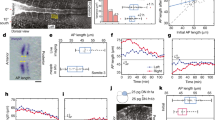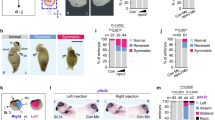Abstract
During early embryonic development, the vertebrate main body axis is segmented from head-to-tail into somites. Somites emerge sequentially from the presomitic mesoderm (PSM) as a consequence of oscillatory waves of genetic activity, called somitogenesis waves. Here, we discuss the implications of the dynamic patterns of early X-Delta-2 expression in the prospective somites (somitomeres) of Xenopus laevis. We report that right somitomeres normally emerge before left to form chiral structures (i.e. structures having clockwise or counter-clockwise handedness). From our observations, we infer that somitogenesis waves are normally counter-clockwise spirals, a novel dynamic mechanism for the control of handedness development in Xenopus. We propose that the same mechanism could control handedness development in all vertebrate embryos, providing a dynamical basis for the current asymmetric molecular transport model for generating left–right asymmetry.








Similar content being viewed by others
References
Aulehla A and Pouquié O 2008 Oscillating signalling pathways during embryonic development. Curr. Opin. Cell Biol. 20 632–663.
Brend T and Holley SA 2009 Balancing segmentation and laterality during vertebrate development. Semin. Cell Developmental. Biol. 20 472–478.
Boterenbrood EC, Narraway JM and Hara K 1983 Duration of cleavage cycles and asymmetry in the direction of cleavage waves prior to gastrulation in Xenopus laevis. Wilhelm Roux’s Arch. Dev. Biol. 192 216–221.
Brown NA and Wolpert L 1990 The development of handedness in left/right asymmetry. Development 109 1–9.
Campanelli M and Gedeon T 2010 Somitogenesis clock-wave initiation requires differential decay and multiple binding sites for clock protein. PLoS Comput. Biol. 6 e1000728.
Cinquin O 2003 Is the somitogenesis clock really cell-autonomous? A coupled-oscillator model of segmentation. J. Theoret. Biol. 224 459–466.
Cohen MH and Durston AJ 2018a Mathematical theory of somitogenesis wave propagation; spiral waves in Xenopus laevis and other embryos. (in preparation).
Cohen MH and Durston AJ 2018b Generation of a left–right morphogen gradient by a spiral somitogenesis wave, a theoretical analysis. (in preparation).
Cohen MH and Robertson A 1971a Wave propagation in the early stages of aggregation of cellular slime molds. J. Theoret. Biol. 31 101–118.
Cohen MH and Robertson A 1971b Chemotaxis and the early stages of aggregation in cellular slime molds J. Theoret. Biol. 31 119–130.
Cooke J and Zeeman EC 1976 A clock and wavefront model for control of the number of repeated structures during animal morphogenesis. J. Theor. Biol. 58 455–476.
Danilchik MV, Brown EE and Riegert K 2006 Intrinsic chiral properties of the Xenopus egg cortex: an early indicator of left–right asymmetry? Development 133 4517–4526.
Davis R, Turner DL, Evans LM and Kirschner MW 2001 Molecular targets of vertebrate segmentation: two mechanisms control segmental expression of Xenopus hairy2 during somite formation. Dev. Cell 1 553–565.
Durston A 1973 Dictyostelium discoideum aggregation fields as excitable media. J. Theor. Biol. 42 483–504.
Gibb S, Maroto M and Dale JK 2010 The segmentation clock mechanism moves up a notch Trends Cell Biol. 20 593–600.
Goodwin BC and Cohen MH 1969 A phase shift model for the spatial and temporal organiza-tion of developing systems. J. Theor. Biol. 25 49–107.
Gros J, Feistel K, Viebahn C, Blum M and Tabin CJ 2009 Cell movements at Hensen’s node establish Left/Right asymmetric gene expression in the chick. Science 324 941–944.
Herrgen L, Ares S, Morelli LG, Schröter C, Jülicher F and Oates AC 2010 Intercellular coupling regulates the period of the segmentation clock. Curr. Biol. 20 1244–1253.
Hubaud A and Pourquié O 2014 Signalling dynamics in vertebrate segmentation. Nat. Rev. Mol. Cell Biol. 15 709–721.
Hubaud A, Regev I, Mahadevan L and Pourquié O 2017 Excitable dynamics and yap-dependent mechanical cues drive the segmentation clock. Cell 171 668–682.
Jiang YJ, Aerne BL, Smithers L, Haddon C, Ish-Horowicz D and Lewis J 2000 Notch signalling and the synchronization of the somite segmentation clock. Nature 408 475–479.
Jouve C, Limura T and Pourquie O 2002 Onset of the segmentation clock in the chick embryo: evidence for oscillations in the somite precursors in the primitive streak. Development 129 1107–1118.
Krinsky VI 1966 Spread of excitation in an inhomogeneous medium. Biofizika 11 676–683.
Kuroda R, Endo B, Abe M and Shimizu M 2009 Chiral blastomere arrangement dictates zygotic left–right asymmetry pathway in snails. Nature 462 790–794.
Lauschke VM, Tsiairis CD, Francois P and Aulehla A 2013 Scaling of embryonic patterning based on phase-gradient encoding. Nature 493 101–105.
Li Y, Fenger U, Niehrs C and Pollet N 2003 Cyclic expression of esr9 gene in Xenopus presomitic mesoderm. Differentiation 71 83–89.
Masamizu Y, Ohtsuka T, Takashima Y, Nagahara H, Takenaka Y, Yoshikawa K, Okamura H and Kageyama R 2006 Real-time imaging of the somite segmentation clock: Revelation of unstable oscillators in the individual presomitic mesoderm cells. PNAS 103 1313–1318.
Moreno TA and Chris Kintner C 2004 Regulation of segmental patterning by retinoic acid signalling during Xenopus somitogenesis. Dev. Cell 6 205–218.
Nakamura T, Mine N, Nakaguchi E, Mochizuki A, Yamamoto M, Yashiro K, Meno C and Hamada H 2006 Generation of robust left–right asymmetry in the mouse embryo requires a self-enhancement and lateral-inhibition system. Dev. Cell 11 495–504.
Nieuwkoop P and Faber J (1956) The normal table of Xenopus laevis (Daudin). North Holland Press, North Holland.
Nonaka S, Tanaka Y, Okada Y, Takeda S, Harada A, Kanai Y, Kido M and Hirokawa N 1998 Randomization of left–right asymmetry due to loss of nodal cilia generating leftward flow of extraembryonic fluid in mice lacking kif3b motor protein. Cell 95 829–837.
Okada Y, Takeda S, Tanaka Y, Belmonte J-C I and Hirokawa N 2005 Mechanism of nodal flow: a conserved symmetry breaking event in left–right axis determination. Cell 121 633–644.
Özbudak EM and Lewis J 2008 Notch signalling synchronizes the zebrafish segmentation clock but is not needed to create somite boundaries. PLoS Genet. https://doi.org/10.1371/journal.pgen.0040015.
Palmeirim I, Henrique D, Ish-Horowicz D and Pourquie O 1997 Avian hairy gene expression identifies a molecular clock linked to vertebrate segmentation and somitogenesis. Cell 91 639–648.
Patel NH 2009 Asymmetry with a twist. Nature 462 727–728.
Peres J, McNulty C and Durston A 2006 Interaction between X-Delta-2 and Hox genes regulates segmentation and patterning of the anteroposterior axis. Mech. Dev. 123 321–333.
Riedel-Kruse IH, Müller C and Oates AC 2007 Synchrony dynamics during initiation, failure, and rescue of the segmentation clock. Science 317 1911–1915.
Ratcliff WC, Fankhauser JD, Rogers DW, Greig D and Travisano M 2015 Origins of multicellular evolvability in snowflake yeast. Nat. Commun. 20 6102.
Sauer S and Klar AJS 2012 Left–right symmetry breaking in mice by left–right dynein may occur via a biased chromatid segregation mechanism, without directly involving the Nodal gene. Front. Oncol. 2 166.
Schubert M, Holland LZ, Stokes MD and Holland ND 2001Three amphioxus Wnt genes (AmphiWnt3, AmphiWnt5, and AmphiWnt6) associated with the tail bud: the evolution of somitogenesis in chordates. Dev. Biol. 240 262–273.
Shiratori H and Hamada H 2006 The left-right axis in the mouse: from origin to morphology. Development 133 2095–2104.
Soroldoni D, Jörg D J, Morelli LG, Richmond DL, Schindelin J, Jülicher F, Oates and AC 2014 A Doppler effect in embryonic pattern formation. Science 345 222–225.
Tabin CJ 2006 The key to left–right asymmetry. Cell 127 27–32.
Vandenberg LN and Levin MA 2013 Unified model for left–right asymmetry? Comparison and synthesis of molecular models of embryonic laterality. Dev. Biol. 379 1–15.
Vermot J and Pourquié O 2005 Retinoic acid coordinates somitogenesis and left–right patterning in vertebrate embryos. Nature 435 215–220.
Wacker SA, Jansen HJ, McNulty CL, Houtzager E and Durston AJ 2004 Timed interactions between the Hox expressing non-organiser mesoderm and the Spemann organiser generate positional information during vertebrate gastrulation. Dev. Biol. 268 207–219.
Wiener N and Rosenblueth A 1946 The mathematical formulation of the problem of conduction of impulses in a network of connected excitable elements, specifically in cardiac muscle. Arch. Inst. Cardiol. Mex. 16 205–265.
Winfree AT 1973 Scroll-shaped waves of chemical activity in three dimensions. Science 181 937–939.
Winfree AT 1972 Spiral waves of chemical activity. Science 1754022 634–636.
Wloch-Salamon DM, Fisher RM and Regenberg B 2017 Division of labour in the yeast: Saccharomyces cerevisiae. Yeast 34 399–406.
Zykova V, Krekhova A and Bodenschatz E 2017 Fast propagation regions cause self-sustained re-entry in excitable media. Proc Natl Acad Sci U S A 114 1281–1286.
Acknowledgements
We are grateful to V Nanjundiah, E Siggia, and M Kirschner for critical and constructive comments. We thank V Nanjundiah for bringing to our attention the possibility of the above reporter experiment. We thank Peter C Newell and Marcel Dekker, Inc., for permission to reproduce figure 4C. We also thank Clifford J Tabin and Cell Press for permission to reproduce figure 6A. We thank an anonymous referee for bringing Hubaud et al. (2017) to our attention and a second anonymous referee for suggestions that signifcantly improved this paper.
Author information
Authors and Affiliations
Corresponding author
Additional information
Communicated by Aurnab Ghose.
Corresponding editor: Aurnab Ghose
Rights and permissions
About this article
Cite this article
Durston, A.J., Peres, J. & Cohen, M.H. Spiral waves and vertebrate embryonic handedness. J Biosci 43, 375–390 (2018). https://doi.org/10.1007/s12038-018-9756-3
Received:
Accepted:
Published:
Issue Date:
DOI: https://doi.org/10.1007/s12038-018-9756-3




